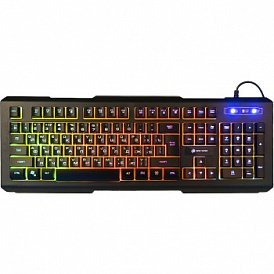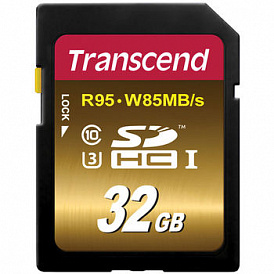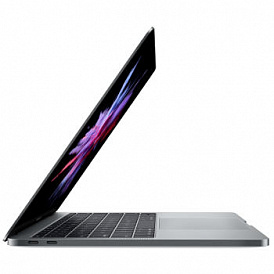Top 15 video cards
A video card is a special expansion card for a computer that takes over all the work on converting graphics. Therefore, neither gamers, nor professional designers and 3D developers can do without it. We have compiled a rating of 15 models of video cards that are suitable for conquering both virtual spaces and new working heights.
Top video card rating
| Nomination | a place | Name of product | price |
| Best cheap graphics cards | 1 | Gigabyte Radeon RX 550 1183Mhz | 7 490 ₽ |
| 2 | Palit GeForce GT 1030 1227Mhz | 6 567 ₽ | |
| 3 | Asus Radeon R7 240 770Mhz | 6 397 ₽ | |
| The best video cards in the middle price segment | 1 | Asus GeForce GTX 1060 6G (ROG Strix-GTX1060-O6G-Gaming) | 24 480 ₽ |
| 2 | Sapphire Nitro + Radeon RX 570 1340Mhz PCI-E 3.0 8192Mb | 23 990 ₽ | |
| 3 | Palit GeForce GTX 1060 1506Mhz PCI-E 3.0 6144Mb | 20 400 ₽ | |
| 4 | MSI GeForce GTX 1050 Ti Gaming X 4G | 14 450 ₽ | |
| 5 | Gigabyte GeForce GTX 1060 1582Mhz | 18 010 ₽ | |
| 6 | Gigabyte Radeon RX 570 Aorus 4G | 19 990 ₽ | |
| Best top-end video cards | 1 | Nvidia Titan X | 76 280 ₽ |
| 2 | Gigabyte GeForce GTX 1080 Ti 1632Mhz PCI-E 3.0 11264Mb | 59 990 ₽ | |
| 3 | MSI GeForce GTX 1080 1708Mhz | 48 010 ₽ | |
| 4 | Asus GeForce GTX 1080 1607Mhz PCI-E 3.0 8192Mb 10000Mhz 256 bit DVI HD | 44 740 ₽ | |
| 5 | Gigabyte GeForce GTX 1070 G1 Gaming 8G (GV-N1070G1 GAMING-8G) | 34 590 ₽ | |
| Top Professional Graphics Cards | 1 | PNY Quadro M6000 PCI-E 3.0 12288M | 106 280 ₽ |
Best cheap graphics cards
Gigabyte Radeon RX 550 1183Mhz
Rating: 4.8
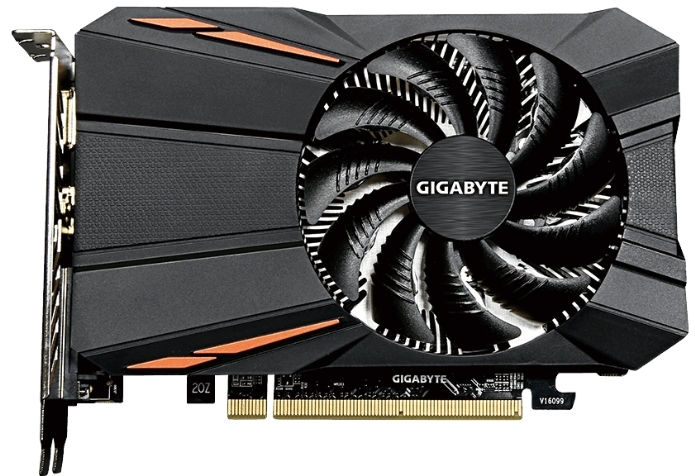
Why first place: The best video card in the budget of up to 10 thousand rubles - 2 GB of video memory, HDMI and DisplayPort connectors, support for CrossFire.
Description: The Gigabyte Radeon RX 550 1183Mhz video card is based on AMD's core with 2 GB of GDDR5 video memory and a clock frequency of 1183 MHz. It supports graphics technology DirectX 12, OpenGL 4.5 and Vulkan, can work in CrossFire mode (in conjunction with another accelerator), equipped with three ports for connecting a monitor - DVI, HDMI 2.0b and DisplayPort 1.4.
To connect to a computer, it uses a PCIe 8x 3.0 bus. The maximum clock frequency of the video memory is 7000 MHz. Computing core Polaris 12 is performed on a 14 nm process technology, which reduces the level of heating. TPD video card - 50 W, while it requires a 400 W power supply.
The video card is equipped with 1 fan.
Virtues
-
One of the cheapest graphics cards based on AMD Radeon RX 550;
-
Supports overclocking up to 1410 MHz in chip and up to 1920 MHz in memory;
-
Silent and cold work in standard load (without acceleration);
disadvantages
-
After acceleration, it starts to noticeably warm up and consume more energy;
-
Acceleration though is, but not too raising productivity;
Palit GeForce GT 1030 1227Mhz
Rating: 4.7
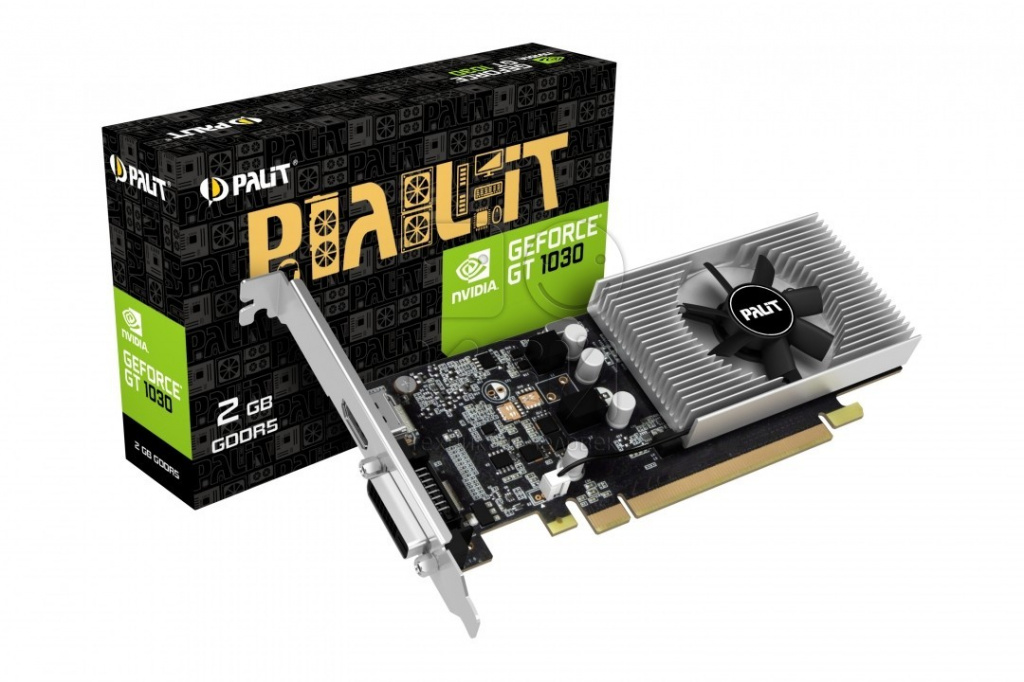
Why second place: One of the cheapest video cards in the ranking, but not of the game, but of the office class.
Description: The Palit GeForce GT 1030 1227Mhz video card is based on the NVIDIA core, but is intended for use in office computers. With a relatively low productivity, it is characterized by a low level of heating and power consumption. The core of Nvidia GeForce GT 1030 has a clock frequency of 1227 MHz, complemented by 2 GB of video memory, operating at 6000 MHz, and is based on a 64-bit bus.
The video card is equipped with two ports - DVI-D and HDMI 2.0b. The maximum supported resolution is 4096 × 2160 pixels. Compatible with graphics technology DirectX 12 and OpenGL 4.5.
Runs in low profile form factor. The TDP is 30 watts, one quiet fan can cope with cooling, and the recommended power supply capacity is only 300 watts.
Virtues
-
Good performance in some games;
-
Low price;
-
Small heat and power consumption;
disadvantages
-
Does not support overclocking;
-
You should not expect high performance in modern games;
-
The package does not include low-profile strap;
Asus Radeon R7 240 770Mhz
Rating: 4.6
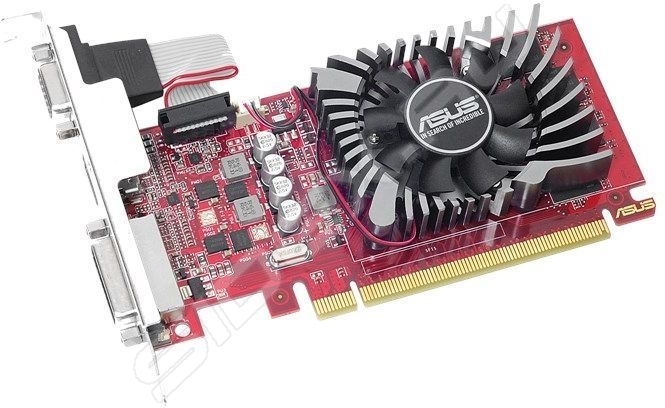
Why third place: The cheapest, but at the same time the least productive video card in the ranking.
Description: The technical characteristics of the Asus Radeon R7 240 770Mhz video card look at least attractive. It is equipped with 4 GB of video memory! But it is worth considering that this video memory is made according to the GDDR3 standard and works at a frequency of 1800 MHz, and the core is at all 770 MHz (in the Boost performance mode - 820 MHz). Therefore, this graphics accelerator is suitable only for not too modern games, and then on medium settings.
The video card is equipped with three connectors for connecting the monitor - VGA, DVI-D and HDMI 1.4a. Supports DirectX 12 and OpenGL 4.5 graphics technology. Maximum compatible resolution - 4096 × 2160 pixels.
Runs in low profile form factor. Heat dissipation (TPD) is 30 W; one fan can cope with cooling. Works with power supplies up to 300 watts.
Virtues
-
Copes with the majority of not very modern games at medium settings;
-
Quiet fan;
-
Low power consumption and heat dissipation;
disadvantages
-
Overclocking can be forgotten;
-
Old video memory;
-
Although it is equipped with 3 connectors, it works with a maximum of 2 monitors;
The best video cards in the middle price segment
Asus GeForce GTX 1060 6G (ROG Strix-GTX1060-O6G-Gaming)
Rating: 4.9
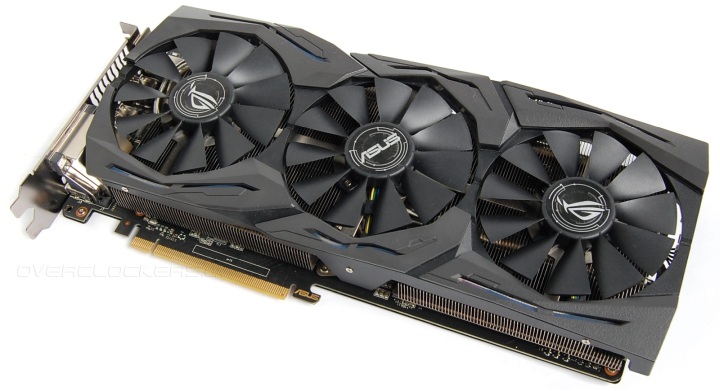
Why first place: The flagship video card at an average (for 2018) price.
Description: The Asus GeForce 1060 GTX 6G video card is based on the corresponding NVIDIA graphics accelerator and is included in the ROG brand line - and this means that it is optimized specifically for gaming. This is evidenced, for example, by a powerful cooling system, including three relatively quiet fans. The graphics accelerator is based on a core with a clock frequency of 1620 MHz (in Boost mode up to 1873 MHz), which is complemented by 6 GB of GDDR5 video memory with a frequency of 8208 MHz.
The video card supports connecting up to 4 monitors. Equipped with DVI-D ports, two HDMI 2.0b and two DisplayPort 1.4. The maximum compatible resolution is 7680 × 4320 pixels. Supports DirectX 12, OpenGL 4.5 and Vulkan. Compatible with CUDA 6.1.
It occupies two expansion card slots, connects via PCIe and needs additional power using an 8-pin connector. TDP is 120 watts. The recommended power supply is 400 watts.
Virtues
-
High gaming performance;
-
Easy and simple setup via bundled software;
-
Elaborate cooling system with adjustable intensity;
disadvantages
-
Large, may not climb in length;
-
Very heavy, it is recommended to use with the strengthened motherboards or special support;
-
Overclocking is not supported (because it is already overclocked "from the factory");
Sapphire Nitro + Radeon RX 570 1340Mhz PCI-E 3.0 8192Mb
Rating: 4.8
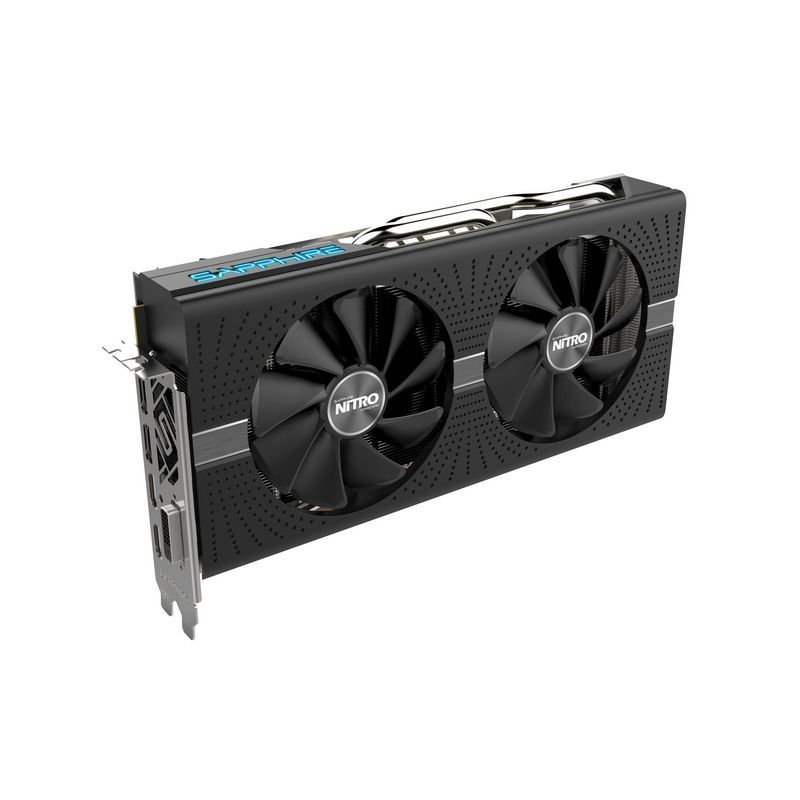
Why second place: Cheaper than the leader of the ranking, but based on AMD chips, although overclocked.
Description: Sapphire Nitro + Radeon RX 570 graphics card is based on the same graphics accelerator from AMD and offers optimal performance for most modern games. The processor clock frequency is 1340 MHz and it is supplemented with 8 GB of GDDR5 video memory with a frequency of 7000 MHz. Supports work in the CrossFire mode (simultaneous connection of two video cards).
Equipped with 5 ports - DVI-D, two HDMI 2.0b and two DisplayPort 1.4. Can work with 5 connected monitors. The maximum resolution is 7680 × 4320 pixels. Compatible with graphics technology DirectX 12, OpenGL 4.5 and Vulkan.
Since the video card is based on the AMD graphics accelerator, it is characterized by high power consumption. TPD is 150 W, although a sophisticated cooling system with two fans copes with heat dissipation. The video card itself requires a power supply of 500 watts.
Virtues
-
8 GB of video memory;
-
Supports GPU overclocking;
-
Sophisticated cooling system;
disadvantages
-
Hynix memory does not support overclocking;
-
No settings coolers;
-
Long and heavy;
Palit GeForce GTX 1060 1506Mhz PCI-E 3.0 6144Mb
Rating: 4.8
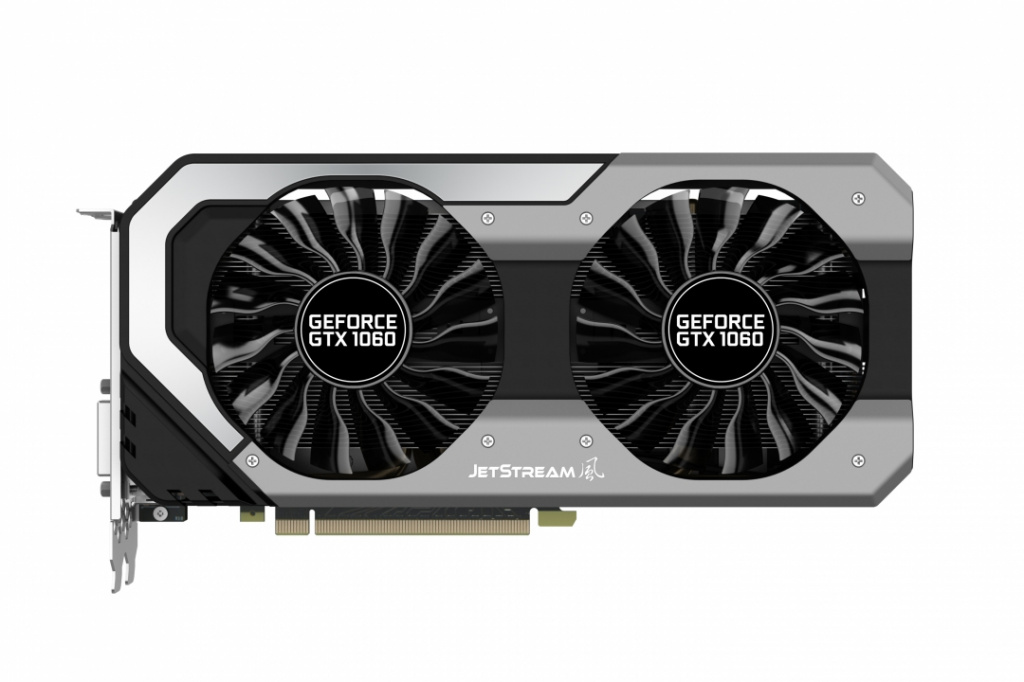
Why the first place: "Unraveled version" of the video card, which took the first place in the rating - although cheaper than the leader.
Description: Palit GeForce GTX 1060 1506Mhz video card is based on the corresponding graphics accelerator from NVIDIA, but was not overclocked by the manufacturer and therefore its core clock frequency is 1506 MHz (in Boost mode it rises to 1708 MHz). It is supplemented by 6 GB of video memory standard GDDR5 with a frequency of 8000 MHz.
The video card supports 4 monitors and is equipped with 5 connectors - DVI-D, HDMI 2.0b and three DisplayPort 1.4. The maximum resolution is 7680 × 4320 pixels. The video card supports graphics and computing technologies DirectX 12, OpenGL 4.5, Vulkan and CUDA 6.1.
Differs developed cooling - two fans effectively dissipate TDP 120 watts. It is recommended to use with a power supply of 400 watts.
Virtues
-
High performance;
-
High-quality assembly;
-
Powerful but quiet cooling;
disadvantages
-
Slow down when playing in 4K resolution;
-
Low-performance and incomprehensible software for independent overclocking;
-
Poor equipment;
MSI GeForce GTX 1050 Ti Gaming X 4G
Rating: 4.7
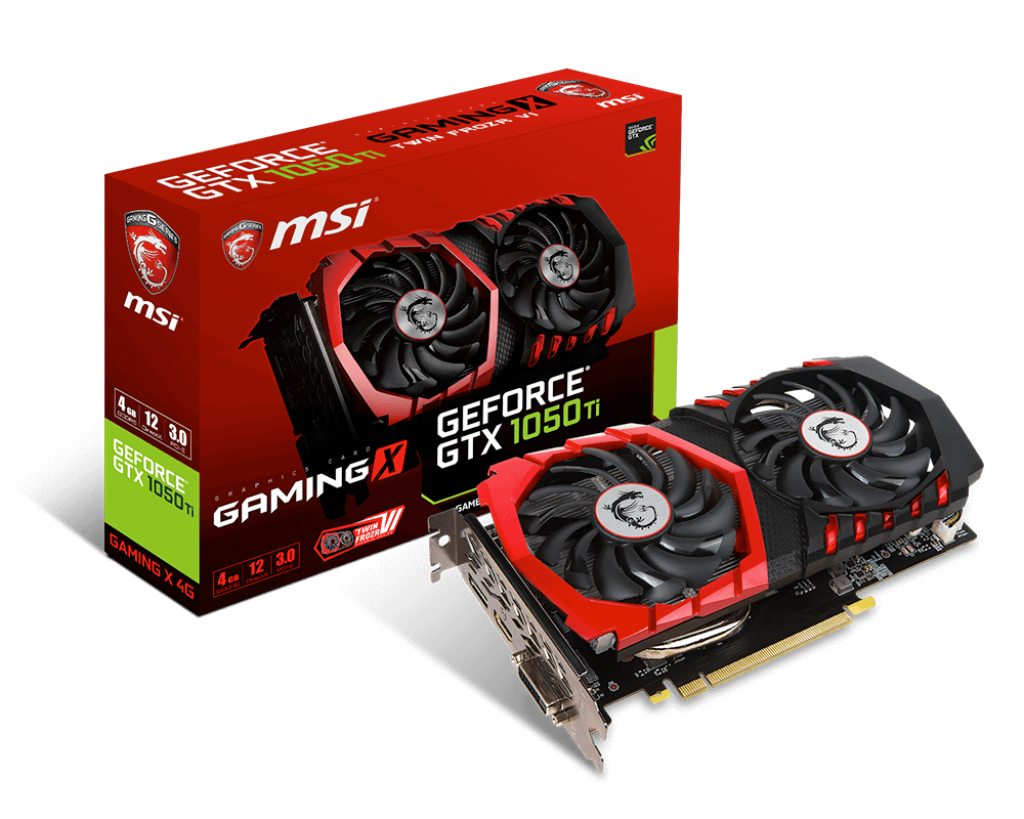
Why fourth place: Slower performance than previous models in the rating, but also one of the lowest prices.
Description: MSI GeForce GTX 1050 Ti Gaming X 4G is the flagship gaming graphics card of the previous generation. In 2018, its performance may seem relatively small compared to other models. In particular, the graphics processor clock frequency is 1379 MHz (in the Boost mode - 1493 MHz), it is supplemented by 4 GB of video memory of the GDDR5 standard with a frequency of 7108 MHz. The video card from the factory is overclocked, so it will be difficult to increase its speed at home.
The video card can work with three connected monitors and is equipped with three connectors - DVI-D, HDMI 2.0b and DisplayPort 1.4. The maximum resolution is 7680 × 4320 pixels. Supports graphics and computing technologies DirectX 12, OpenGL 4.5, CUDA 6.1 and Vulkan.
Differs in low power consumption. The TDP of a video card is 75 W, two coolers cope with heat dissipation. The recommended minimum power supply is 300 watts.
Virtues
-
Excellent combination of performance and power consumption;
-
Highlighting and attractive design;
-
Three modes of operation - Silent, OS, Gaming;
disadvantages
-
Micron's memory is hard to overclock;
-
Few settings of the complete software;
-
After acceleration and under high load it starts to make a lot of noise;
Gigabyte GeForce GTX 1060 1582Mhz
Rating: 4.6
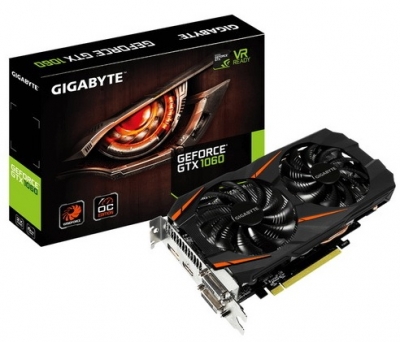
Why fifth place: A video card with good performance and not the most successful design - plastic backplate and memory without radiators.
Description: Gigabyte GeForce GTX 1060 is based on the same graphics accelerator from NVIDIA, however, it offers a more budgetary configuration than the top models. In particular, its core is overclocked to 1582 MHz (in the Boost mode - up to 1797 MHz). The clock frequency of the video memory is 8008 MHz, and the volume - 6 GB.
The video card supports connecting up to 4 monitors simultaneously and a maximum resolution of 7680 × 4320 pixels. It is equipped with four ports - two DVI-D, one HDMI 2.0b and one DisplayPort 1.4. Supports graphics and computing technologies DirectX 12, OpenGL, OpenCL 1.2, Vulkan and CUDA 6.1.
Heat dissipation (TDP) of the video card is 120 watts. Two fans are used for cooling. The recommended power supply is 400 watts.
Virtues
-
Compact, fits into most cases;
-
Equipped with video memory from Samsung;
-
Good performance;
disadvantages
-
Plastic backplate, not very reliable and not badly cooled;
-
Strange port configuration (two DVI-D, but only one HDMI);
-
No radiators in memory;
Gigabyte Radeon RX 570 Aorus 4G
Rating: 4.5
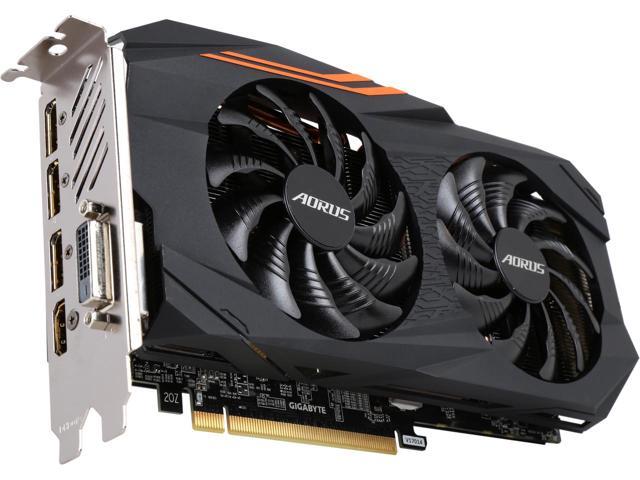
Why sixth place: 4 GB of video memory, but at the same time more expensive than MSI GeForce GTX 1050 Ti Gaming X with the same volume, which took fourth place in the ranking.
Description: The Gigabyte Radeon RX 570 Aorus 4G video card is based on the same accelerator from AMD and partially overclocked by the manufacturer. The core clock frequency is 1280 MHz, and GDDR5 video memory, which here is 4 GB - 7000 MHz.
The video card supports connecting up to 5 monitors simultaneously, and the maximum compatible resolution is 7680 × 4320 pixels. It is equipped with one DVI-D connector, one HDMI 2.0b and three DisplayPort 1.4 ports. The video card is compatible with DirectX 12, OpenGL 4.5, OpenCL 2.0 and Vulkan. It can work in SLI / CrossFire mode.
Heat dissipation (TDP) of the video card is 150 watts. 2 fans are used for cooling. It is recommended to connect the video card to a power supply with a capacity of 450 W or higher.
Virtues
-
Supports overclocking, and very good;
-
Quiet operation;
-
The cooling radiator is not sealed;
disadvantages
-
Relatively poor performance without overclocking;
-
Leaking thermal pads, so you should regularly clean the PCIe port;
-
Three DisplayPort ports, but only one HDMI;
Best top-end video cards
Nvidia Titan X
Rating: 4.9
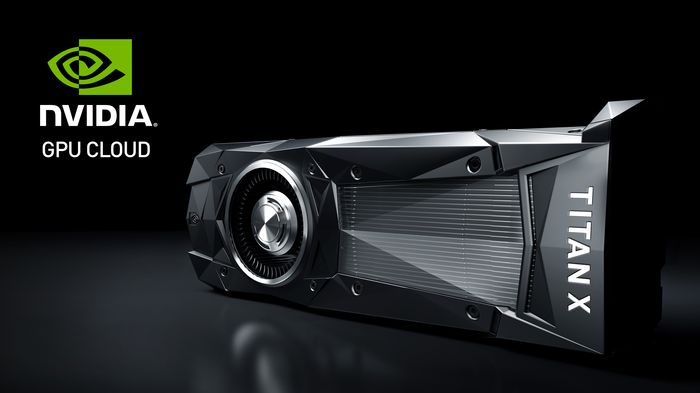
Why the first place: There is nothing more powerful than this video card in the rating.
Description: Titan X is the most powerful consumer video card from 2018. And let the clock frequency of the GPU at 1000 MHz not confuse - it is enough to handle even the most complex visual solutions. The video memory in the device is 12 GB, and the GDDR5 generation is used. For example, in the flagship games, it consistently “gives out” 80 fps at 4K resolution and set maximum graphics settings. If we speak in numbers, the performance of this video card is 120 teraflops.
The video card is equipped with 5 connectors - one DVI-I, one HDMI 2.0 and three DisplayPort 1.4. Supports DirectX 12, OpenGL 4.5, CUDS 6.1, Vulkan and OpenCL 1.4. It can work in SLI mode.
The video card has a heat dissipation of 250 W, so the reference cooler with an evaporation chamber is used for cooling. Two ports are used for power supply - 8-pin and 6-pin.
Virtues
-
12 GB of video memory GDDR, 110 teraflops;
-
"Pull" and modern, and future games;
-
Sophisticated cooling system;
disadvantages
-
Expensive, with the main competitor - GTX 1080 - cheaper;
-
Heavy, needs an enhanced motherboard;
-
Oversized;
Gigabyte GeForce GTX 1080 Ti 1632Mhz PCI-E 3.0 11264Mb
Rating: 4.9
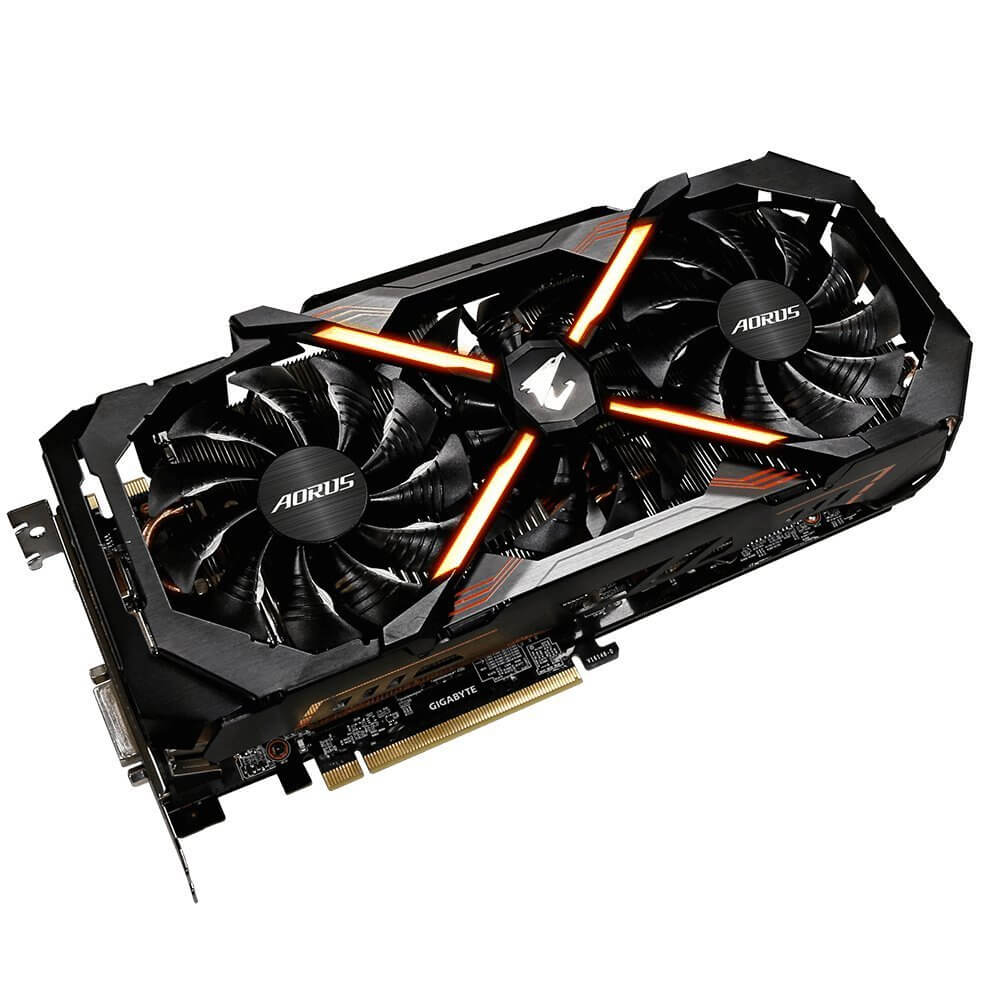
Why second place: Less video memory than the leader of the ranking.
Description: The Gigabyte GTX 1080 Ti video card is based on the Nvidia graphic accelerator of the same name, whose core is overclocked by the manufacturer to 1632 MHz (1746 MHz in Boost mode), and this is not the limit. It is also equipped with 11 GB of GDDR5 video memory with a frequency of 11,448 MHz. This achieves very high gaming performance.
The video card supports connecting up to 4 monitors simultaneously with a maximum resolution of 7680 × 4320 pixels. Equipped with 7 connectors: one DVI-D, three HDMI 2.0b and three DisplayPort 1.4. Supports DirectX 12, OpenGL 4.5, CUDA 6.1, Vulkan and OpenCL 1.2. It can work in SLI mode.
The video card has a high power consumption. TDP is 250 W, for cooling, three fans with a custom heat removal system are used. Recommended for use with a 600 watt power supply.
Virtues
-
High performance in current and future games;
-
Attractive design;
-
Elaborate air cooling system;
disadvantages
-
Heavy, needs additional support;
-
Few settings in the bundled software;
-
High cost;
MSI GeForce GTX 1080 1708Mhz
Rating: 4.8
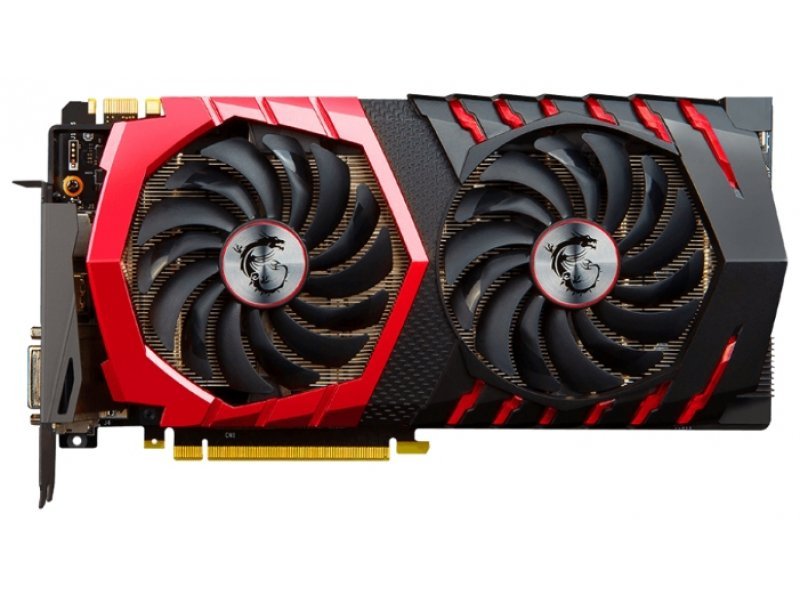
Why third place: Slower performance and clock frequency than the previous model in the rating, but the price is lower.
Description: MSI GeForce GTX 1080 is based on a slightly overclocked version of the corresponding graphics accelerator by the manufacturer. So, the core clock frequency is 1708 MHz (in Boost mode it rises to 1847 MHz). It is supplemented with 8 GB of video memory standard GDDR5X, operating at 10,108 MHz.
Supports up to 4 monitors simultaneously with a maximum resolution of 7680 × 4320 pixels. The video card is equipped with 5 connectors - one DVI-D, one HDMI 2.0b and three DisplayPort 1.4. Compatible with DirectX 12, OpenGL 4.5, CUDA 6.1, Vulkan and OpenCL 1.2, can connect in SLI mode.
The heat dissipation of the video card (TDP) is 180 W, 2 cooling fans and custom radiators are used for cooling. Recommended for use with a power supply of 500 W or more.
Virtues
-
Overclocking;
-
Powerful software for setting work parameters;
-
Suddenly quiet operation with thoughtful fan control;
disadvantages
-
Under load, choke noise is heard;
-
Limited backlight settings;
-
Poor equipment;
Asus GeForce GTX 1080 1607Mhz PCI-E 3.0 8192Mb 10000Mhz 256 bit DVI HD
Rating: 4.7
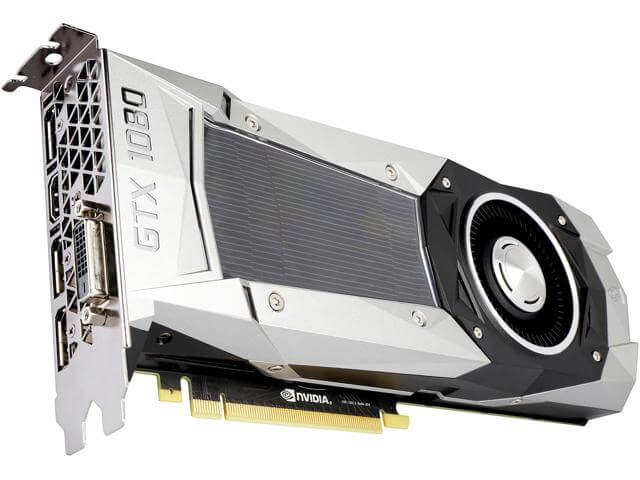
Why fourth place: It uses a kernel that was not overclocked by the manufacturer.
Description: Asus GeForce GTX 1080 video card is based on the corresponding NVIDIA graphics accelerator, however, unlike previous models in the rating, its core is almost not overclocked by the manufacturer - the clock frequency is 1607 MHz with an increase in Boost mode to 1733 MHz. It is supplemented with 8 GB of video memory standard GDDR5X, operating at 10,010 MHz.
The video card supports connecting up to 4 monitors with a maximum resolution of 7680 × 4320 pixels. It is equipped with five ports - one DVI-D, one HDMI 2.0b and three DisplayPort 1.4. Supports DirectX 12, OpenGL 4.5, CUDA 6.1 and Vulkan technologies, can work in SLI mode.
It needs additional power, but only one 8-pin connector is enough. The heat dissipation is 180 W; the reference cooler with an evaporator is used for cooling. Recommended for use with 500 W or higher power supplies.
Virtues
-
Powerful cooling, in most games the temperature does not exceed 60 degrees;
-
High performance;
-
Quiet operation;
disadvantages
-
Limited overclocking capabilities;
-
Large and heavy;
-
8 GB of video memory may not be enough for some programs;
Gigabyte GeForce GTX 1070 G1 Gaming 8G (GV-N1070G1 GAMING-8G)
Rating: 4.7
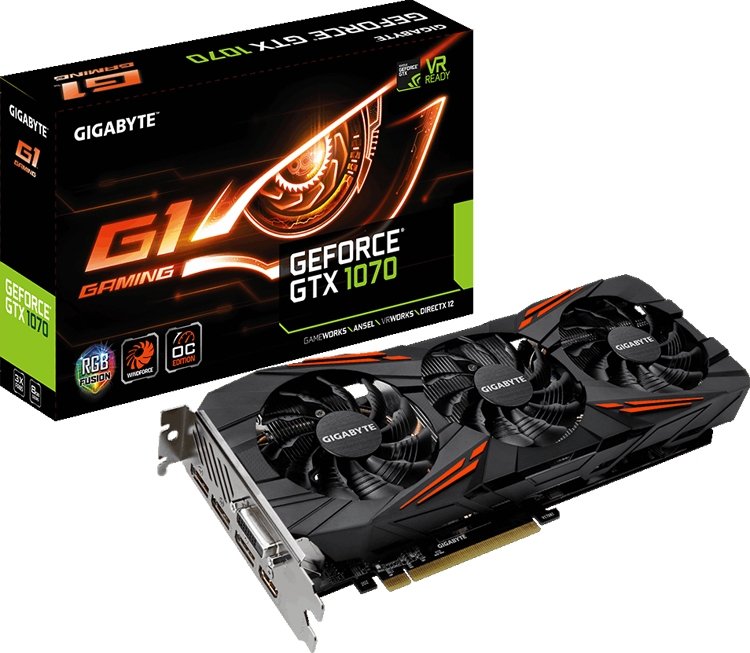
Why the fifth place: The minimum overclocking by the manufacturer, the only in this segment of the rating video card based on Nvidia GeForce GTX 1070.
Description: The Gigabyte GeForce GTX 1070 G1 Gaming 8G video card is based on the corresponding Nvidia graphics accelerator with minimal factory overclocking. In particular, its computational core operates at 1594 MHz (in the Boost mode, at 1822 MHz). It is supplemented with 8 GB of video memory, made by GDDR5 technology with an effective frequency of 8008 MHz.
The video card supports up to 4 simultaneously connected monitors with a maximum resolution of 7680 × 4320 pixels. It is equipped with five ports - one DVI-D, one HDMI 2.0b and three DisplayPort 1.4. Supports DirectX 12, OpenGL 4.5, OpenCL 1.2, CUDA 6.1, Vulkan and NVIDIA proprietary technologies. It can work in SLI mode.
Heat dissipation (TDP) of the video card is 150 watts. For cooling, 3 axial fans and a custom radiator are used. The recommended power supply capacity is 500 W and higher.
Virtues
-
Supports overclocking up to 2,100 MHz core;
-
Aluminum backplate that increases strength and improves cooling;
-
Elaborate cooling system with low noise level;
disadvantages
-
Small memory overclocking;
-
Under high load whistling chokes appear;
-
Poor equipment;
Top Professional Graphics Cards
PNY Quadro M6000 PCI-E 3.0 12288M
Rating: 4.9
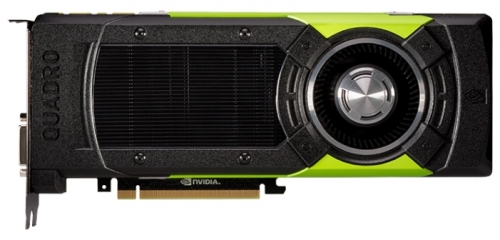
Why it is this: RAMDAC 400 MHz, 384-bit memory bus, FSAA - 64x.
Description: The video card PNY Quadro M6000 is based on the corresponding GPU from NVIDIA and is intended for 3D modeling, rendering and similar operations. It is equipped with 12 GB of video memory standard GDDR5, based on a 384-bit bus and supports RAMDAC at 400 MHz.
Up to 4 monitors with a maximum resolution of 4096 × 2160 pixels can be simultaneously connected to a video card. It is equipped with five connectors - one DVI-I with HDCP support and four DisplayPort. The video card is compatible with software interfaces DirectX 12 and OpenGL 4.5. It can work in SLI mode. Supports CUDA technology.
Heat dissipation (TDP) of the video card is 250 watts. For cooling, a reference system with an evaporator is used.
Virtues
-
The best combination of price and performance in the Nvidia Quadro series;
-
High memory bus width;
-
Effective cooling system based on the evaporator and the "turbine";
disadvantages
-
No HDR support;
-
Maximum screen resolution - 4K;
-
High power consumption and TDP compared to P series models;
Attention! This rating is subjective, is not advertising and does not serve as a guide to the purchase. Before buying, you should consult with a specialist.










